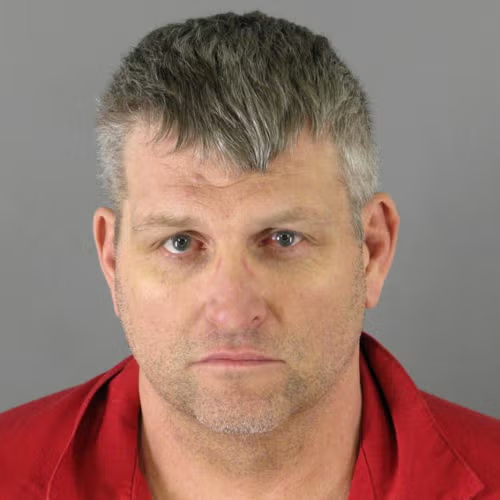
Table of Contents
Who Is Keith Hunter Jesperson?
Keith Hunter Jesperson is a notorious serial killer, known for the horrific murders he committed between 1990 and 1995. Often targeting vulnerable individuals, such as sex workers and casual acquaintances, Jesperson raped and strangled his victims, leaving their bodies scattered across several U.S. states, including Oregon, California, Florida, Nebraska, and Washington. His occupation as a long-haul truck driver facilitated his mobility and ability to evade capture. Jesperson gained infamy as the “Happy Face Killer” due to the smiley face symbols he included in his anonymous confessions, which he wrote on bathroom walls and in letters to newspapers before his identity was known. His criminal history extended beyond murder, as it also included acts of animal cruelty, arson, and sexual assault.
Early Life
Jesperson was born on April 6, 1955, in British Columbia, Canada. He grew up in an abusive household, where his father frequently disciplined him with violence. Jesperson’s childhood was marked by cruelty towards animals, a common indicator of future violent behavior. He was bullied and ostracized by his peers due to his large size, earning nicknames like “Monster Man” and “Igor.” His early experiences of social rejection and abuse may have contributed to the violent path he later followed.
Victims
Jesperson’s first known victim was Taunja Bennett, a 23-year-old woman with developmental disabilities whom he murdered on January 21, 1990. He lured her to his house, where he assaulted and strangled her.
In 1992, Jesperson claimed more victims, including an unidentified woman known only as “Claudia,” whose body was found in California, and Cynthia Lynn (Rose) Wilcox, although he later denied killing Wilcox. He continued his spree, murdering women across different states, many of whom remain unidentified. His pattern was consistent: he would strangle his victims and discard their bodies, often leaving little trace for investigators.
Jesperson’s final victim was his girlfriend, Julie Winningham, whom he killed in Washington state on March 10, 1995. Her body was discovered shortly after, leading to Jesperson becoming a suspect and eventually confessing not only to her murder but to seven others as well. While Jesperson has claimed to have killed as many as 166 people, only eight murders have been definitively attributed to him.
Becoming the “Happy Face Killer”
Following his first murder, Jesperson remained undetected for several years. However, in an unusual twist, two innocent people, Laverne Pavlinac and her boyfriend, John Sosnovske, were wrongfully convicted for the murder of Taunja Bennett. Pavlinac had falsely confessed to aiding Sosnovske in the crime to escape her abusive relationship. Despite her recanting the confession, both were convicted in 1991.
Frustrated by the lack of recognition for his crimes, Jesperson began leaving anonymous confessions, often signing them with a smiley face. These confessions, left in public restrooms and later mailed to The Oregonian newspaper, eventually earned him the moniker “Happy Face Killer.” His detailed knowledge of the murders, particularly information only the true killer would know, eventually led to his arrest. In 1995, authorities realized that Pavlinac and Sosnovske were innocent, and they were released from prison.
Despite his claim of having taken far more lives, only eight murders have been confirmed as Jesperson’s. His case remains one of the most chilling examples of how a seemingly ordinary individual can lead a double life as a brutal killer.
Capture and Confession
Jesperson became a suspect in the murder of Julie Winningham after her body was discovered, as he was known to be her boyfriend. Following the investigation, Jesperson attempted suicide but ultimately confessed to the crime. Before his arrest, he wrote a letter to his brother in which he revealed, “I am sorry that I turned out this way. I have been a killer for five years and have killed eight people.” His brother handed this letter over to law enforcement, further implicating Jesperson in multiple murders.
Sentencing and Incarceration
While in custody, Jesperson provided detailed confessions about the eight murders he committed. He was sentenced to multiple life terms for several of these crimes but avoided the death penalty. Jesperson is currently incarcerated at the Oregon State Penitentiary, where he spends much of his time creating artwork. Some of his pieces have appeared on “murderabilia” websites, where items connected to notorious criminals are sold.
Personal Life
Jesperson married Rose Hucke on August 2, 1975, and the couple had three children: two daughters and a son. They divorced in 1989. His eldest daughter has recounted traumatic memories from her childhood, including instances of Jesperson committing acts of animal cruelty, such as killing kittens.
Media Depictions
Jesperson’s life has been the subject of various media portrayals. The television movie Happy Face Killer, starring David Arquette as Jesperson, aired in 2014.
Several books have also explored his story. Jack Olsen’s I: The Creation of a Serial Killer (2002) provides an in-depth look at Jesperson’s life, while M. William Phelps wrote a memoir, Dangerous Ground: My Friendship with a Serial Killer (2017), about his interactions with Jesperson.
Jesperson’s eldest daughter, Melissa G. Moore, authored Shattered Silence: The Untold Story of a Serial Killer’s Daughter (2009), which recounts her experiences. She also addressed her father’s crimes in the podcast Happy Face.
Watch Happy Face Killer on Lifetime Movie Club.
